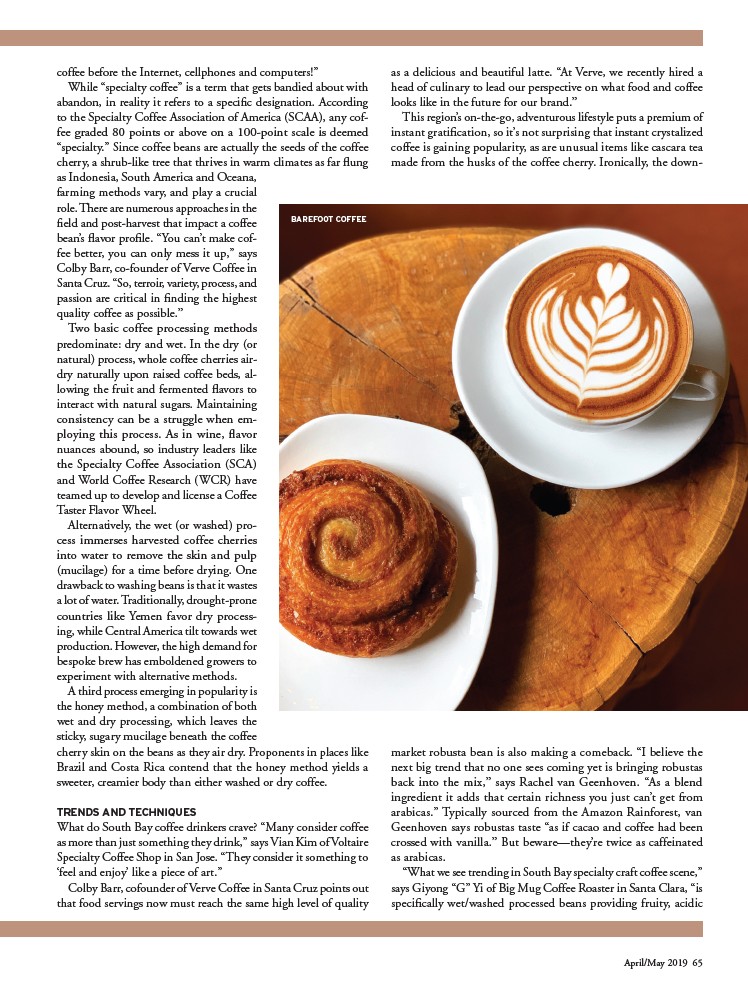
April/May 2019 65
coffee before the Internet, cellphones and computers!”
While “specialty coffee” is a term that gets bandied about with
abandon, in reality it refers to a specific designation. According
to the Specialty Coffee Association of America (SCAA), any coffee
graded 80 points or above on a 100-point scale is deemed
“specialty.” Since coffee beans are actually the seeds of the coffee
cherry, a shrub-like tree that thrives in warm climates as far flung
as Indonesia, South America and Oceana,
farming methods vary, and play a crucial
role. There are numerous approaches in the
field and post-harvest that impact a coffee
bean’s flavor profile. “You can’t make coffee
better, you can only mess it up,” says
Colby Barr, co-founder of Verve Coffee in
Santa Cruz. “So, terroir, variety, process, and
passion are critical in finding the highest
quality coffee as possible.”
Two basic coffee processing methods
predominate: dry and wet. In the dry (or
natural) process, whole coffee cherries airdry
naturally upon raised coffee beds, allowing
the fruit and fermented flavors to
interact with natural sugars. Maintaining
consistency can be a struggle when employing
this process. As in wine, flavor
nuances abound, so industry leaders like
the Specialty Coffee Association (SCA)
and World Coffee Research (WCR) have
teamed up to develop and license a Coffee
Taster Flavor Wheel.
Alternatively, the wet (or washed) process
immerses harvested coffee cherries
into water to remove the skin and pulp
(mucilage) for a time before drying. One
drawback to washing beans is that it wastes
a lot of water. Traditionally, drought-prone
countries like Yemen favor dry processing,
while Central America tilt towards wet
production. However, the high demand for
bespoke brew has emboldened growers to
experiment with alternative methods.
A third process emerging in popularity is
the honey method, a combination of both
wet and dry processing, which leaves the
sticky, sugary mucilage beneath the coffee
cherry skin on the beans as they air dry. Proponents in places like
Brazil and Costa Rica contend that the honey method yields a
sweeter, creamier body than either washed or dry coffee.
TRENDS AND TECHNIQUES
What do South Bay coffee drinkers crave? “Many consider coffee
as more than just something they drink,” says Vian Kim of Voltaire
Specialty Coffee Shop in San Jose. “They consider it something to
‘feel and enjoy’ like a piece of art.”
Colby Barr, cofounder of Verve Coffee in Santa Cruz points out
that food servings now must reach the same high level of quality
as a delicious and beautiful latte. “At Verve, we recently hired a
head of culinary to lead our perspective on what food and coffee
looks like in the future for our brand.”
This region’s on-the-go, adventurous lifestyle puts a premium of
instant gratification, so it’s not surprising that instant crystalized
coffee is gaining popularity, as are unusual items like cascara tea
made from the husks of the coffee cherry. Ironically, the downmarket
robusta bean is also making a comeback. “I believe the
next big trend that no one sees coming yet is bringing robustas
back into the mix,” says Rachel van Geenhoven. “As a blend
ingredient it adds that certain richness you just can’t get from
arabicas.” Typically sourced from the Amazon Rainforest, van
Geenhoven says robustas taste “as if cacao and coffee had been
crossed with vanilla.” But beware—they’re twice as caffeinated
as arabicas.
“What we see trending in South Bay specialty craft coffee scene,”
says Giyong “G” Yi of Big Mug Coffee Roaster in Santa Clara, “is
specifically wet/washed processed beans providing fruity, acidic
BAREFOOT COFFEE